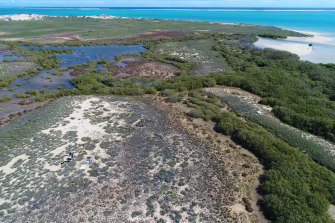
University of Western Australia researcher Dr Sharyn Hickey was the lead author on the new paper and was able to determine the breadth of north-west mangroves by analysing time points over a four-year period.
This is because peak canopy coverage, or greenness, fluctuates with the El Niño-Southern Oscillation – four-year weather cycles of varying winds and sea surface temperatures.

Researchers collected data in Mangrove Bay near Exmouth.Credit:Sharyn Hickey/UWA
“It’s a significant finding because mangroves are at the forefront for mitigation activity with storing and sequestering blue carbon or providing coastal protection,” Hickey said.
Previous research, including a study by Hickey in Mangrove Bay near Exmouth, has found the deadly tree disease dieback can happen in El Niño conditions, which coincide with low sea levels and little rainfall on the west coast.
Dry conditions in a 2015-16 El Niño year led to a 7000-hectare die-off of mangroves in the Gulf of Carpentaria in the Northern Territory, which resulted in millions of tonnes of carbon being released from the soil.
Hickey’s latest paper did not delve into how climatic changes have impacted the broad area of north-west mangroves, but she said there was a need for further research to explore and understand how climate was influencing their footprint.
Rising seas could see a mangrove retreat
The mangroves of the north-west are a hardy group.
In the Kimberley, they must deal with periods of complete inundation by seawater and then the extremes of drying up with no tide at all.
Both the Pilbara and Kimberley fall within the state’s cyclone alley and can suffer big die-offs from destructive winds and seas.
Loading
But it is sea level rise that will have one of the biggest impacts.
The United Nation’s International Panel on Climate Change said in a report three years ago that by 2100 the ocean could be 30-60 centimetres higher by 2100 even if greenhouse gas emissions are sharply reduced and warming is limited to below 2 degrees Celsius.
If emissions continue this could be more in the range of 60-110 centimetres.
University of Queensland marine ecologist Professor Catherine Lovelock has studied mangroves for decades including in WA and says these systems would start retreating inland as sea levels increased.
She said in accepting northern WA as an industrial hub, there had to be room left for the mangroves so they didn’t run into literal walls.
“There’s really not enough formal protection for coastal ecosystems in the north ... it would be good to have a more systematic approach rather than what’s left over from the mining industry,” she said.
Lovelock said development in the north-west should look to nature-based solutions and how mangroves could be used to protect infrastructure.
The academic also wanted to see a greater focus on the cumulative impacts of industry, something the WA Environmental Protection Authority has flagged it could do as an extension of its recent study on the Exmouth Gulf.
Industry has had a firm foothold in the Pilbara for decades, but geoheritage practitioner Vic Semeniuk has been one of the voices championing its significance as having the most diverse and complex arid coastline in the world.
Loading
“The Pilbara Coast is a coastline of global significance and, ideally, it should have been inscribed as a site of World Heritage as representative of an arid coastal system that markedly contrasts with other arid coasts worldwide,” Semeniuk wrote in 2015.
“From an Australian national perspective, it is the most arid coast in Australia and should have been inscribed as a site of National Heritage.”
Because of a lack of current data on industrial influences on mangroves, the EPA tasked the Kerry Stokes-backed Mardie salt and potash project south of Karratha, through its initial environmental approval, with proving it would not have an adverse impact on the Robe River Delta mangroves.
The proponent, BCI Minerals, also has to spend money researching the impact of sea level rise on mangroves, samphire and algal mat areas on the Pilbara coast, and mapping the extent of the latter two vegetation types.
Loading
The EPA is still considering another salt project off Exmouth Gulf while oil and gas giant BP recently bought a major stake in the proposed $US36 billion Asian Renewable Energy Hub near 80 Mile Beach, which is also home to mangroves.
The hub would cover a 668,0000-hectare site with wind turbines and solar panels but was knocked back by the federal government last year because of the potential to create a toxic dead zone because of plans to disturb 345 hectares of seabed at the nearby RAMSAR-listed beach.
A revised application is expected to be made.
Protect Ningaloo director Paul Gamblin said the combination of industrial development, clearing of ecosystems and sea level rise could result in an environmental decline.
“It’s a concern we don’t know what the baseline extent has been or what the level of impact has been over the last few decades and yet there are more big proposals that have implications for mangroves,” he said.
Follow WAtoday on Instagram, LinkedIn, Facebook and Twitter for handpicked selections of the day’s biggest local, national and international news.









 Add Category
Add Category